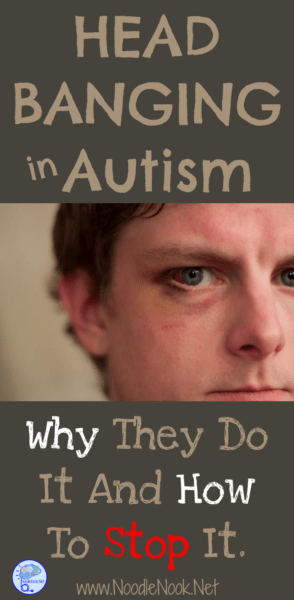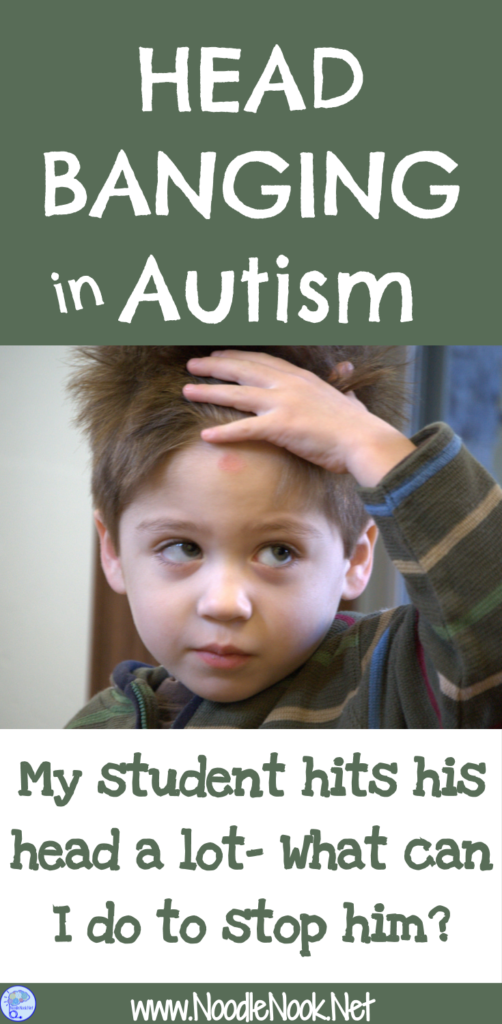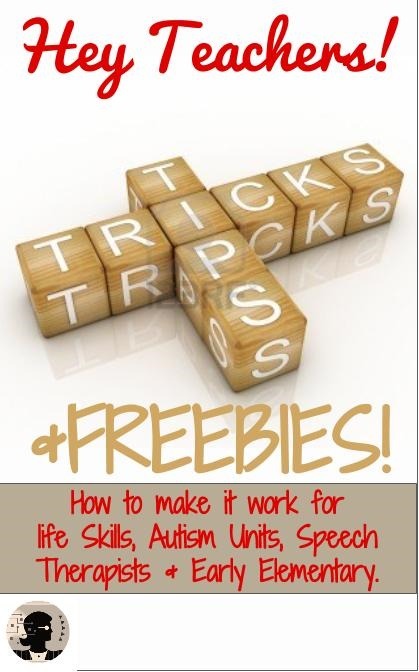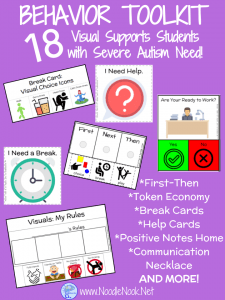“I have a student in my class with pretty severe behaviors- he hits his head a lot. Like all the time. I feel bad when he goes home some days with huge red marks on his face, but I’m not sure what to do to get him to stop. What can I do?”
– Kenneth J.
Head Banging in Autism
Kenneth, I feel you. It is pretty hard as a teacher to sit back and watch a kid seriously hurt themselves. Head banging in Autism is actually very common. There are a handful of tricks you can try to lessen the rate and severity of head-hitting, but first you want to try to figure out the reason behind the hitting.
The Function of Head Banging in Autism
There are several reasons a child with Autism might have self-injurious behavior like head banging or head hitting. I always, always, always suggest trying to figure out the function of behavior before you try to mold a replacement behavior. It just helps you get less error in the trial and error process.
With head banging, there are 4 primary reasons for the behavior:
- Pain
- Communicate
- Attention Seeking
- Sensory
So let’s go over these really quick…
1. Pain. I worked with a student once who started self-injury kind of out of the blue. We had the hardest time figuring out what had suddenly changed, and after weeks we finally figured it out. The student had an abscessed tooth and it was super painful. He was hitting to alleviate the pain. I still cringe when I think of the days and days that went by before we figured it out and were able to get him help to address the tooth pain. With external pain, like a toothache or an ear infection, the head banging is done to distract from the pain.
2. Communication. Does your student have a way to communicate? Imaging you were in a foreign country where you didn’t speak the language. You want something and you’ve asked for it over and over again, but no one seems to understand you. You’d start to get super frustrated… wouldn’t you? Well, when a student doesn’t have a way to share wants and needs, that can be equally frustrating. That may be the cause of the behavior- sheer frustration.
3. Attention Seeking. You may be playing into the behavior and not even know it. When the connection has been made that head banging will get a reaction and garner attention, a student can start to head bang more to get more of the attention. What is your reaction? Do you stop everything and run over? You may be reinforcing the attention seeking.
4. Sensory. A student could like the sensory feeling of head banging as a form of stimming. The self-stimulation (stimming) behavior is pleasurable. Or, conversely, there is too much sensory information and the head banging is a way to shut out all of the other sensory “noise” when they are overloaded. So sensory can go either way… to increase the sensory input, or decrease the sensory input.
Strategies to Stop Head Banging
Injury Prevention when Pain:
- Provide student with a helmet.
- Consider padding the area to protect the student.
- Track date/time/antecedent to determine if pain induced.
Decrease Sensory:
- Consider noise cancelling headphones.
- Try sensory “breaks” in the classroom.
Increase Sensory:
- Try massaging the head using fingers or a brush to comb hair.
- Use a vibration tool like a vibrating pillow or vibrating massager.
- Use a yoga ball, a rocking chair, or even a scented candle/lotion.
Provide Attention Appropriately:
- Use a token system to provide positive reinforcement and choice.
- Use a timer system to intermittently provide positive attention.
Communication System:
- Work with PECS or AAC system to teach yes-no and a few basic core words (finished, stop, want).
- Use visual in the classroom to support communication.
Don’t Ignore the Behavior
I have heard the advice given to people in the past- “Just ignore the head banging… it’s probably for attention”. Please, please don’t ignore it and think it’s going to go away. There is a reason for the behavior and you absolutely must address it.
If you don’t think any of the other methods mentioned above will work, try straight redirection. I have a 2 year-old in my house who will, like all toddlers, run off the rails sometimes by having a melt down. If I can catch it early enough, I will distract before it gets bad with a simple “Ohh, look at that!” while looking out the doorway/window/over yonder. Sometimes a convincing distraction can avert a behavior- but ignoring it never will.
[tweetthis]Why students with Autism hit themselves and what to do about it- Practical Guide![/tweetthis]
Putting Together a Plan for Head Banging
So… with the basics outlined, how do you even start? First decide on the function of the behavior. If you need help on determining function, check out this earlier post: What’s the Function. You can also check out these behavior data sheets with a guide on accurate collection.
If you are not sure about the function and you want to start right now, here’s the plan:
1. Put some visuals in place. On a student’s desk put a “I need a break” card or “Finished” icon on the desk.
2. Get a timer. Use it to limit the demands on a student (set the timer so a student is able to work for short cycles). You can alternatively set it for yourself to remember to praise a student to provide the positive attention intermittently.
3. When you see the behavior coming (or it starts) limit the sensory information in the classroom. Lower the lights, limit the noise, and allow your student to sit in a different or preferred spot in the classroom. This is also a great time to lighten the load by minimizing the academics or presenting them in smaller chunks.
4. Use a rocking chair, yoga ball, or non-traditional desk/chair to change the sensory situation.
5. Assess the situation. Did it improve or worsen? Time to get some padding and protective items in the classroom for the student? Now is the time to check.
6. Make a sign for ‘safe hands’ or ‘hands on desk’ (whichever you prefer).
7. Grab the timer back and find a motivating object to use as a reinforcer (and it may be an edible). Start to reward your student for small intervals with no head banging- the time will depend on the student. Maybe it is only 30 seconds and you will reward with a “Good job with safe hands’. Slowly increase the amount of time until you start to see longer intervals without head banging.
Remember, you will try these one at a time and allow some processing to see the effect of each one. Also take a second to jot down a few notes on how the step impacts the student’s behavior. If you dim the lights, does it get worse? Then the student may head bang because of not enough sensory. When they use the chair, ball, or vibrator does the behavior escalate? Then is is probably sensory overload. Or maybe when the work is limited or minimized the head banging is reduced- it is probably attention behavior to escape.
This can be a really slow process. Be patient and vigilant.
Head Banging in the Classroom
It can be super horrifying when you see a student hurting themselves and unable to help… but you are not powerless. Try this plan and see what progress you make. Remember, you are looking for the function of the behavior as you work with the steps.
How is it going? Please comment below or share strategies that have worked for you! Remember to pin, tweet, post, and share this article to help others help their students.









Thanks so much for this info , I had a student this year that was banging his head often. My first thought was the helmet. However, the parent refused . The School OT made a weighted hat that he wears off and on he also wears a sweat band around his head daily . It really helped him greatly. He is rarely hitting his head now . The sensory input along with the use of a visual schedule has helped so much !
Jenna,
I am so glad it helped and thanks for the positive comment. I hope others will be able to find this article and have as much success as you have!
Thank you very much for this information, I work in supporting Autism and challenging behavior, when staff use their own emotions at times of self injurious behavior it makes the behavior worse. I have sourced information from others sites but this article us very good and informative, I will ask them to view this on your site.
Thanks so much for the praise on the post and I hope your staff does come and check it out. Share it, post it and pin it- I think so many people can better help students with the information here. Thanks again!
My grandson has behavior problems. It’s mainly while driving in the car. He slaps himself in the face hard, and spits. When you stop the car or make a right or left turn he will slap and spit. Any ideas or advice would be appreciated
Hi Eileen my son is six and had some problems while driving wasn’t done in the direction he had in his mind. Now with navigation system he is able to see exactly where are we going and he memorise every route we take 😉 it makes him happy and calms him down.
I have a grand daughter who has been banging her head for 2 years now. Our ABA therapist has told us that its a learned behavior and to ignore it. Its not working and we’re so beyond ourselves with frustration.
Comments are closed.